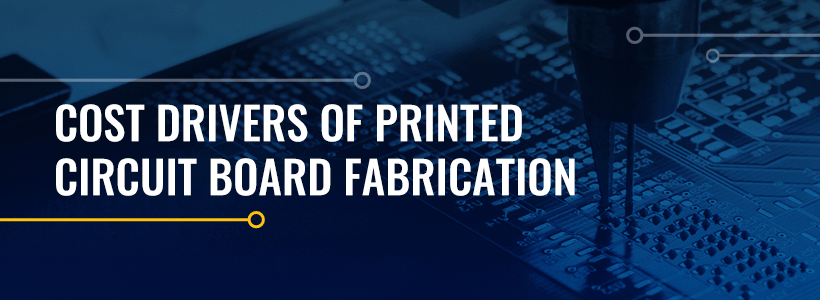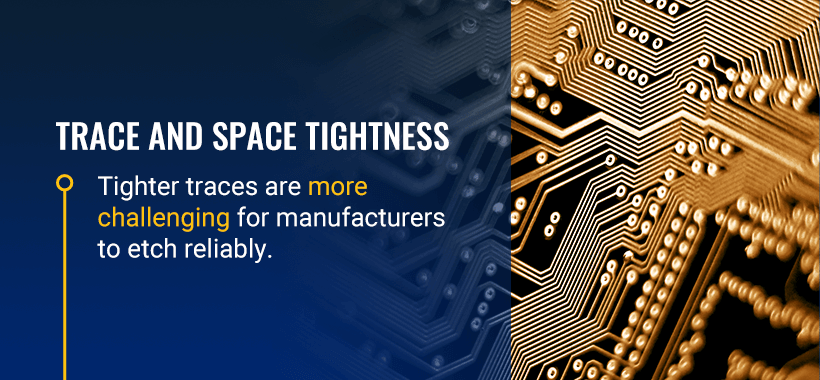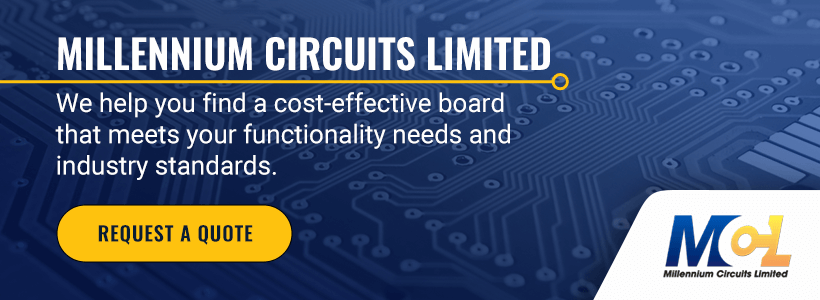
Printed circuit boards (PCBs) have many factors that can change the price during fabrication. From the sizing and materials to the specific processes used, the elements you choose for your PCB drastically drive up the cost. Understanding what can lead to changes in the price can help you select a PCB that best meets your budget and needs.
12 Factors Affecting PCB Fabrication Cost
Several factors can function as PCB fabrication cost drivers. Understanding where you might experience higher costs at the production and processing stages of your PCBs can help you make cost-effective decisions that can ensure the quality of your products while saving money.
1. PCB Size
The size and shape of your PCB can impact its costs as they increase. Expanding the PCB’s size will require more materials and time to manufacture the final product, leading to rising costs. PCB price will increase in proportion to the board’s surface area, which you can use to calculate how much extra your product will cost as you expand beyond the standard sizing.
2. Effective Utilization of Materials
Effective utilization of materials correlates closely to size and spacing. When you choose a PCB with a smaller size, you will use fewer materials, making it a more cost-effective option. However, even if you elect to use a larger size, you can cut costs on materials by effectively using your available space to minimize waste and only use what you need. Finding an arrangement that optimizes your space and size can help ensure you are using only what you need.
3. Layer Count
Like the size and material usage, you can expect the price to rise as you add more layers to your PCB. Costs increase for additional layers for many reasons. When you add more layers, you will need more materials for each layer, and it will take longer to produce with extra etching and bonding steps.
Further, adding more layers often increases the chances of your PCB experiencing defects in the testing stages, so your manufacturer might account for this in your quote when you request a board with multiple layers. Your manufacturer will need to inspect each layer, raising these costs.
Typically, costs rise the most after adding two to four additional layers, costing around 35-40% more. However, you can expect the cost per layer to decrease after that. Adding four to six layers will raise costs by around 30-40% more, and adding six to eight will increase them by 30-35%.
4. Complexity
The further your PCB strays from standard and conventional board technology, the higher your costs. More complex configurations and designs will require more time to assemble with extra steps.
While a simple PCB might require one of each processing step, a complex one can take three or four additional steps that simple boards do not need, like laser drilling. They might also require specialized personnel or equipment that will cost you more.
5. Material Choice
Depending on the materials you choose, you can experience fluctuations in price. Some materials are more cost-effective than others, allowing you to save money on your PCB production. While you might need some higher-quality materials for specific board functions, choosing materials that best fit your budget can help you reduce costs.
6. Trace and Space Tightness
Your PCB’s trace is essential since it is responsible for its electrical carrying capacity. However, how you arrange your trace on the PCB and the design’s relationship with how much available space you have can impact the price. Tighter traces are more challenging for manufacturers to etch reliably, causing them to raise prices for these services.
7. Hole Size and Quantity
Many hole-related factors can cause you to pay more for your PCB fabrication, but hole size is the most prevalent. Smaller holes are more challenging and will require more specialized training and tools, leading to higher costs. When holes reach a specific size, lasers are required for precision.
When you have higher quantities of holes, it will take your manufacturer more time, causing further increases in costs. Additionally, if there are several layers or thicker materials, you can expect higher costs to accommodate the necessary manufacturing time.
8. Controlled Impedance
Like trace tightness, a controlled impedance will require designing and producing very specific or uniform trace width and spacing. Many factors in these processes can lead to higher prices, from the specific materials needed to achieve the desired result to the necessary testing procedures.
9. Tight Tolerances
When you have tight tolerances in your PCB design, it automatically increases the complexity of your board, which already results in higher costs. Further, tight tolerances can sometimes cause fitting issues with the board’s fit or function, leading to troubleshooting costs.
10. Copper Foil Weights
The weight of your copper foils relates closely to using materials effectively. Thicker copper is more expensive and comes with additional challenges and costs. You will likely need to use more prepreg in your processing steps to fill gaps between copper. Since thicker copper is heavier, you might also experience higher transportation costs.
11. Soldermask, Legend/Silkscreen and Carbon Print
When designing your PCB, you should consider the production steps your manufacturer will need to complete it. Including soldermask, legend/silkscreen and carbon print will require separate processes for each, which will require more of a time investment.
Prices can also change if processes require specialized equipment or tools. The materials you select for operations can raise the price if you choose a higher-quality or thicker solder mask, for example.
12. Surface Finishes
Depending on the surface finish you choose for your PCB, costs can fluctuate. You can find standard and basic finishes, like OSP and HASL, which are more cost-effective and still offer decent solderability. However, some other finishes can lead to increases in price.
LF HASL, Imm Ag, Imm SN and ENIG each vary in terms of price, with LF HASL being the most cost-effective and ENIG being the most expensive. Further, prices will change depending on how many layers you need for each material. Choosing a more cost-effective surface finish option can help you cut costs for your PCB fabrication.
Request a Quote From Millennium Circuits Limited Today
Understanding the factors that can drive up PCB fabrication costs can help you find a cost-effective board that meets your functionality needs and industry standards.
At Millennium Circuits Limited (MCL), we have 15 years of experience supplying PCBs. We serve several unique industries to help meet their specific applications and needs, including consumer electronics, vehicles and marine and industrial equipment. We work to supply several types of PCBs, from rigid and flex boards to alternative materials like aluminum, ceramic and heavy copper.
Request a quote from MCL today.



